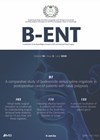
Journal Reviews
Measurement of HINTS in peripheral vestibulopathy
Dizziness; Head impulse test; Nystagmus; Skew deviation; Vertigo.
Indication and timing of electrodiagnostic tests in facial palsy
This excellent review describes the benefits and limitations of electrodiagnostic testing for patients with facial paralysis. Tests such as Schirmer, stapedial reflex and electrogustometry have been largely replaced by neurophysiologic tests like nerve excitability test (NET), electroneuronography (ENoG), surface electromyography...
Treatment options for vestibular neuritis: systematic review and meta-analysis
Vestibular neuritis (VN) is the third most common cause of peripheral vertigo. VN has been postulated to have viral aetiology and historically it was treated with steroids, until 2011 when a Cochrane review demonstrated lack of robust evidence behind this...
Olfactory function and vitamin D
This Turkish prospective study evaluated olfactory function in individuals with primary vitamin D deficiency and the effect of replacement therapy on olfactory function over an eight-month period in 2019. A total of 91 individuals with vitamin D insufficiency were included,...
Olfactory and gustatory recovery in coronavirus patients after six months
It remains unclear for how long olfactory and gustatory losses persevere in patients with COVID-19. This is a prospective study of 300 patients who lost taste and smell within seven days of contracting COVID-19. The patients were objectively assessed with...
Alcohol and hearing
Alcohol is a well-known central nervous system depressant. Individual reactions to alcohol might vary, but the connection between alcohol consumption and tolerance to loud noise or difficulties in communication in noisy environments are well-observed phenomena; for example, at evening parties....
Recording of electrode voltages (REVS) to determine extra-cochlear electrodes
Determining whether electrodes are sitting within the cochlea can be difficult as the checks run by the programming software cannot always determine this. In some cases, patients may be unable to give the audiologist detailed feedback which can complicate the...
Nasal function in COVID-19 patients
This Turkish prospective study compared SNOT-22 outcomes as well as objective assessments of nasal secretion and clearance in 40 patients who tested positive on COVID-19 antigen PCR testing and 40 patients who tested negative. Sinonasal findings were assessed using a...
A predictor of successful treatment of posterior canal BPPV
Reversal of nystagmus on returning to the upright sitting position from the Hallpike position is a common observation. However, its relevance as a predictor of a successful canal repositioning manoeuvre (CRM) is not known, hence this study. The retrospective study...
The vestibular system is not immune to chronic otitis media
It is well recognised that chronic otitis media (COM) is a risk factor for sensorineural hearing loss. Studies on the effect of COM on vestibular function have been beset by design biases. The authors designed a case control study to...
Impaired vestibulo-ocular reflex (VOR) gain correlates with hearing loss in vestibular schwannoma
The lack of correlation between the size of vestibular schwannoma (VS) and degree of hearing loss and vestibular function tests is well known. In this retrospective study, the focus was on the correlation between VOR gain of semicircular canal function,...
Chorda tympani in middle ear surgery
This was a prospective study at a single Belgian centre that aimed to monitor postoperative taste problems after middle ear surgery. The authors also looked at the influence of pathology and manipulation of chorda tympani (CT) on its function. Taste...















